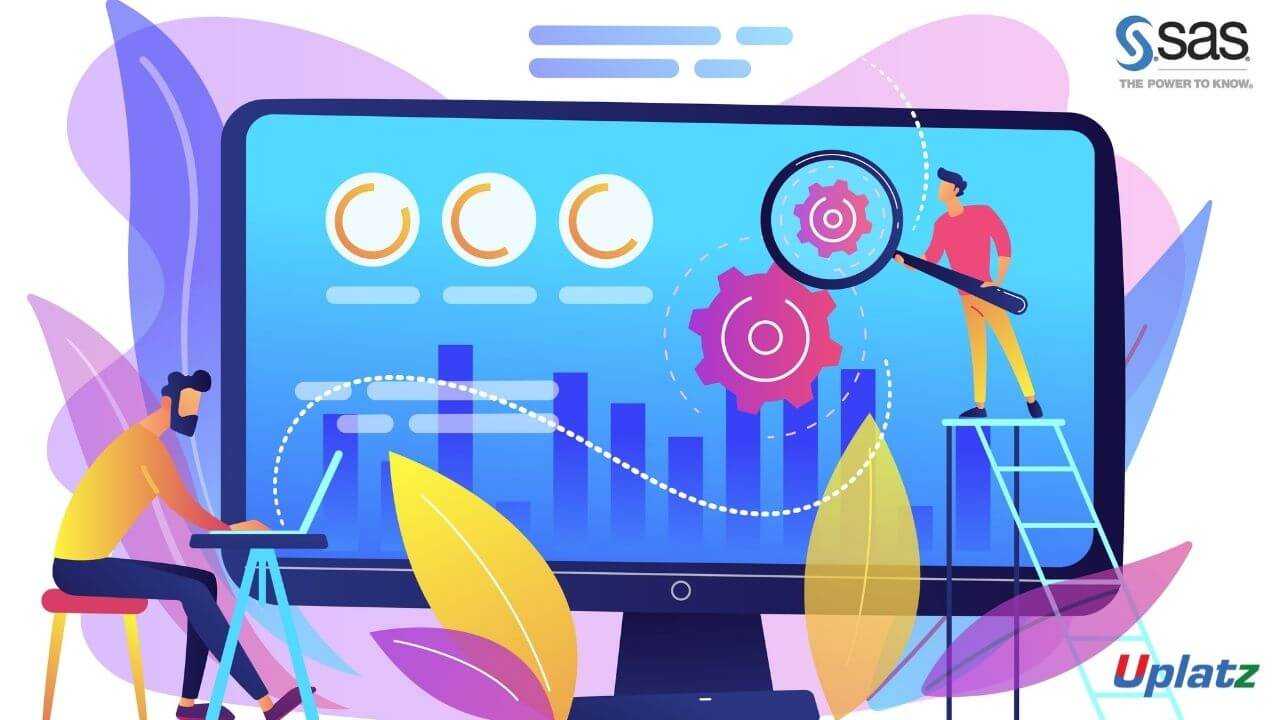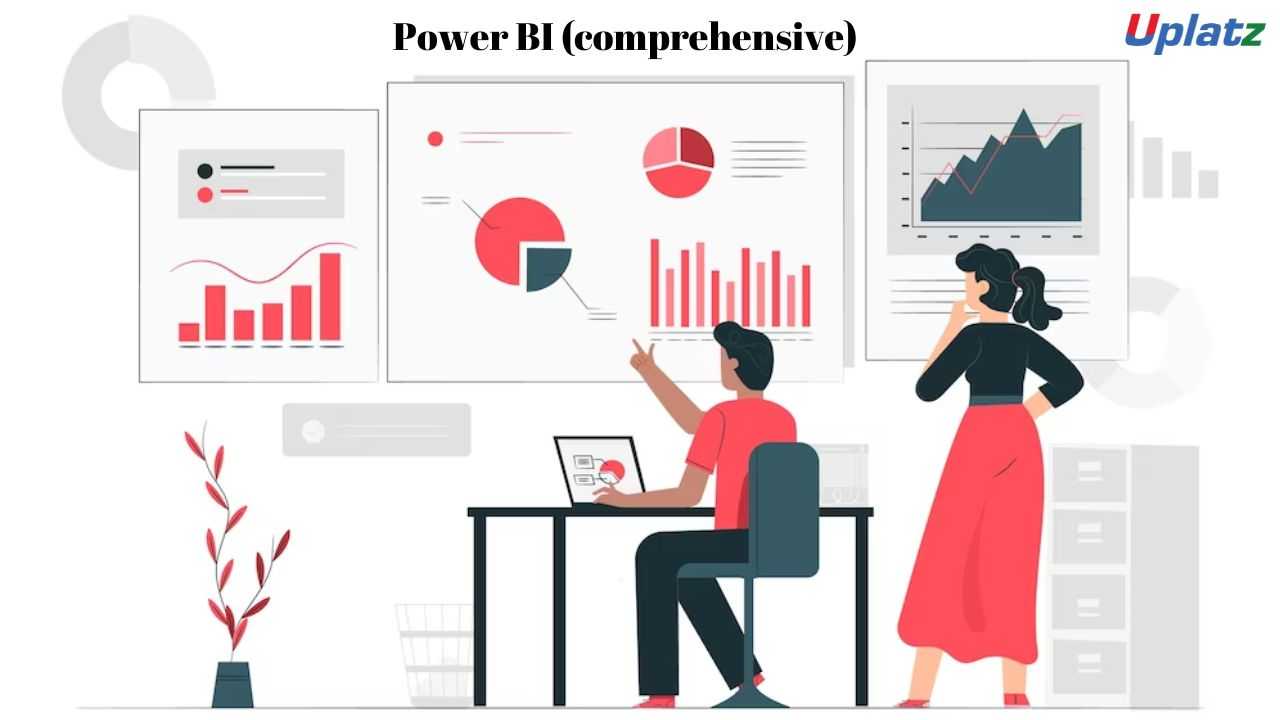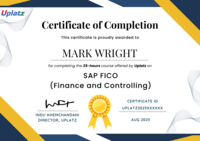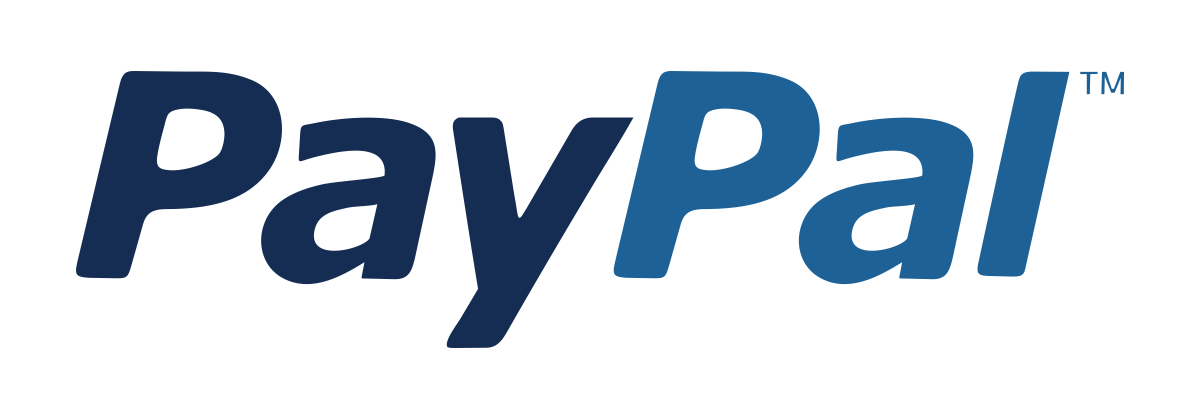SAS Viya Platform Administration
Learn SAS Viya Architecture, Deployment & Configuration, Security Management, Monitoring & Performance, Backup & Recovery, User Management, and more.Preview SAS Viya Platform Administration course
Price Match Guarantee Full Lifetime Access Access on any Device Technical Support Secure Checkout Course Completion Certificate 97% Started a new career
BUY THIS COURSE (
97% Started a new career
BUY THIS COURSE (GBP 12 GBP 29 )-
 90% Got a pay increase and promotion
90% Got a pay increase and promotion
Students also bought -
-

- Premium Career Track - Chief Data Officer (CDO)
- 600 Hours
- GBP 39
- 4405 Learners
-

- SAS BI (Business Intelligence) and Data Integration Studio
- 15 Hours
- GBP 12
- 1555 Learners
-

- Power BI (comprehensive)
- 18 Hours
- GBP 12
- 471 Learners

SAS Viya is an AI and analytics platform designed to help businesses leverage their data for better decision making. It offers a suite of tools that cover the entire data lifecycle, from data preparation and analysis to model deployment and management. SAS Viya is a cloud-enabled, in-memory analytics engine designed to provide quick and efficient data analysis. SAS Viya Platform Administration involves managing and maintaining the infrastructure and components of the SAS Viya environment to ensure its optimal performance and security.
Key Features of SAS Viya include:
1) Faster and More Productive: SAS Viya boasts of significant performance improvements in data processing and AI tasks compared to competing platforms. This translates to faster turnaround times and increased productivity for data scientists and analysts.
2) Language Agnostic: SAS Viya allows users to work in their preferred coding language, be it SAS, Python, or R. This flexibility caters to programmers with varying backgrounds and skillsets.
3) Cloud-Based: SAS Viya can be deployed on-premise or in the cloud, offering businesses scalability and flexibility depending on their needs.
SAS Viya Platform Administration involves the following key elements:
1. Infrastructure Management: This includes provisioning and configuring servers, managing network settings, and ensuring adequate hardware resources to support SAS Viya components.
2. Component Deployment: SAS Viya consists of various components such as Compute Server, Metadata Server, LASR Analytic Server, and others. The administration involves deploying and configuring these components according to the organization's requirements.
3. Security Administration: Admins are responsible for implementing security measures to protect data and resources within the SAS Viya environment. This involves managing user access, roles, permissions, and encryption mechanisms.
4. Monitoring and Performance Tuning: Admins monitor the health and performance of SAS Viya components using tools like SAS Environment Manager. They optimize performance by fine-tuning configurations, allocating resources efficiently, and troubleshooting issues.
5. Backup and Recovery: Admins implement backup and recovery strategies to ensure data integrity and minimize downtime. This involves scheduling regular backups, testing recovery procedures, and maintaining disaster recovery plans.
6. User Support and Training: Admins provide support to users, troubleshoot issues, and offer guidance on using SAS Viya features effectively. They may also conduct training sessions to educate users on best practices and new features.
7. Integration and Collaboration: SAS Viya integrates with other systems and tools within the organization's IT ecosystem. Admins facilitate seamless integration and collaboration between SAS Viya and other platforms, ensuring data flows smoothly and securely.
8. Patch Management and Upgrades: Admins apply patches and updates to SAS Viya components regularly to address security vulnerabilities and enhance functionality. They also plan and execute version upgrades to leverage new features and improvements.
SAS Viya Platform Administration plays a crucial role in ensuring the stability, security, and optimal performance of the SAS Viya analytics platform, enabling organizations to derive actionable insights from their data effectively. As an administrator, you'll be responsible for the smooth operation and maintenance of the SAS Viya platform. The key day-to-day tasks you will be contributing towards are:
1) Installation and Configuration: Setting up the SAS Viya platform on the chosen infrastructure (cloud or on-premise) and configuring it to meet the specific needs of the organization.
2) User Management: Creating and managing user accounts, ensuring data security and access control.
3) Performance Monitoring: Keeping an eye on system performance, identifying and troubleshooting any issues that might arise.
4) System Maintenance: Performing regular backups, updates, and upgrades to ensure the platform is running smoothly and securely.
Since SAS Viya is a comprehensive platform, having a strong understanding of data management, security, and cloud technologies would be beneficial for a SAS Viya Platform Administrator. Your role could potentially lead to other data-related careers within the organization, such as data analyst or data scientist.
Uplatz provides this intense SAS Viya Platform Administration course that will help you gain sound understanding of the SAS Viya platform and how to administer it effectively and efficiently.
Course/Topic 1 - Course access through Google Drive
-
Google Drive
-
Google Drive
The key objectives of this SAS Viya Platform Administration course are:
1. Understanding SAS Viya Architecture: Students learn about the architecture of SAS Viya, including its various components, their interactions, and their roles in the analytics ecosystem.
2. Deployment and Configuration: Students learn how to deploy SAS Viya components, configure them based on organizational requirements, and integrate them with existing IT infrastructure.
3. Security Management: Students understand security principles and best practices for SAS Viya, including user authentication, authorization, encryption, and data protection mechanisms.
4. Monitoring and Performance Optimization: Students learn how to monitor the health and performance of SAS Viya components using tools like SAS Environment Manager and optimize performance through configuration tuning and resource allocation.
5. Backup and Recovery: Students learn backup and recovery strategies for SAS Viya, including scheduling backups, testing recovery procedures, and maintaining disaster recovery plans to ensure data integrity and minimize downtime.
6. User Management and Support: Students learn how to manage user accounts, roles, and permissions within SAS Viya, as well as providing user support, troubleshooting common issues, and conducting training sessions for end-users.
7. Integration and Collaboration: Students learn how to integrate SAS Viya with other systems and tools within the organization's IT ecosystem, facilitating seamless data flow and collaboration between different platforms.
8. Patch Management and Upgrades: Students understand the importance of applying patches and updates to SAS Viya components regularly to address security vulnerabilities and enhance functionality, as well as planning and executing version upgrades.
9. Performance Tuning and Optimization: Students learn techniques for optimizing the performance of SAS Viya, including fine-tuning configurations, optimizing resource utilization, and troubleshooting performance bottlenecks.
10. Compliance and Governance: Students understand compliance requirements and governance principles relevant to SAS Viya, ensuring that the platform adheres to regulatory standards and organizational policies regarding data privacy, security, and governance.
The SAS Viya Platform Administration course aims to equip students with the knowledge and skills necessary to effectively manage, secure, and optimize SAS Viya environments, enabling organizations to derive maximum value from their analytics investments while ensuring data integrity, security, and compliance.
This course provides a comprehensive introduction to administering the SAS Viya platform, focusing on the essential skills and knowledge needed to effectively manage and maintain the environment. Participants will learn how to deploy, configure, and secure SAS Viya applications, as well as how to monitor performance and troubleshoot common issues.
Module 1: Introduction to SAS Viya
The course begins with an overview of SAS Viya, exploring its architecture, components, and key features. Participants will understand the differences between traditional SAS and SAS Viya, focusing on the advantages of the cloud-based environment. This module sets the foundation for effective administration by discussing the system requirements and installation processes.
Module 2: Installation and Configuration
In this module, students will learn the step-by-step process for installing SAS Viya. Topics include preparation for installation, configuration of deployment options, and the use of SAS Deployment Manager. Participants will gain hands-on experience in setting up various components such as SAS Cloud Analytic Services (CAS), metadata servers, and web applications.
Module 3: User Administration and Security
Effective user management is crucial for maintaining a secure SAS Viya environment. This module covers user roles, permissions, and authentication methods, including LDAP and SAML. Participants will learn how to create and manage users, groups, and access controls, ensuring that sensitive data is protected and that users have the necessary access for their roles.
Module 4: Monitoring and Performance Tuning
This module focuses on the tools and techniques used to monitor the performance of the SAS Viya platform. Participants will explore SAS Environment Manager and other monitoring tools to analyze system performance metrics. Additionally, the course will cover strategies for performance tuning, resource allocation, and optimization of CAS server operations.
Module 5: Data Management and Integration
In this section, participants will learn how to manage and integrate data within the SAS Viya environment. Topics include data access, data preparation, and data governance. The module will also cover techniques for integrating with external data sources, including databases and cloud storage, ensuring that users can leverage data effectively for analytics.
Module 6: Troubleshooting and Maintenance
Troubleshooting common issues and performing routine maintenance are key skills for any administrator. This module will guide participants through common problems that may arise in SAS Viya, including error identification and resolution strategies. Participants will also learn about backup, recovery, and update procedures to maintain system integrity.
Module 7: Advanced Topics and Best Practices
To conclude the course, participants will explore advanced administration topics such as multi-tenancy, advanced security configurations, and system upgrades. This module will emphasize best practices for SAS Viya administration, focusing on ensuring a robust and efficient analytic environment.
Course Conclusion and Certification:
The course will wrap up with a review of the key concepts covered and provide guidance on further resources for ongoing learning. Participants will have the opportunity to take a certification exam to validate their skills in SAS Viya platform administration.
SAS Viya is a cloud-enabled, in-memory analytics platform that provides a unified environment for managing and analyzing data. It integrates with various SAS products and is designed to handle large-scale data analytics efficiently. For professionals focusing on SAS Viya Platform Administration, there are key certifications that validate skills in managing and optimizing the SAS Viya environment. Here’s an overview of the top SAS Viya certifications and their benefits:
1. SAS Certified Platform Administrator for SAS Viya
Overview:
a) Purpose: This certification is designed for professionals who manage and administer the SAS Viya platform. It validates foundational knowledge in configuring, managing, and maintaining the SAS Viya environment.
b) Content: Covers installation and configuration of SAS Viya, system monitoring, user management, data integration, and troubleshooting within the Viya environment.
Benefits:
a) Foundational Knowledge: Demonstrates your understanding of essential administrative tasks and best practices for managing SAS Viya.
b) Career Entry: Ideal for individuals new to SAS Viya administration or those starting their career in managing SAS environments.
c) Industry Recognition: Provides a recognized credential that enhances your resume and job prospects for entry-level to mid-level SAS Viya administrative roles.
2. SAS Certified Advanced Platform Administrator for SAS Viya
Overview:
a) Purpose: This certification focuses on advanced administrative tasks and best practices for managing complex SAS Viya environments.
b) Content: Includes advanced configuration, performance tuning, security management, high availability, and disaster recovery for SAS Viya.
Benefits:
a) Advanced Skills: Validates your ability to handle complex administrative tasks and optimize SAS Viya environments for better performance and reliability.
b) Career Progression: Suitable for those looking to advance their career in SAS Viya administration with a focus on more intricate system management.
c) Professional Recognition: Enhances your credentials for senior administrative roles and complex project management in SAS Viya environments.
3. SAS Certified Cloud Administrator for SAS Viya
Overview:
a) Purpose: This certification is designed for administrators managing SAS Viya in cloud environments. It covers cloud-specific configurations and best practices for operating SAS Viya in cloud settings.
b) Content: Includes cloud deployment, configuration, management, and optimization of SAS Viya, focusing on cloud infrastructure and services.
Benefits:
a) Cloud Expertise: Demonstrates your ability to manage SAS Viya effectively in cloud environments, which is increasingly relevant as organizations adopt cloud solutions.
b) Career Relevance: Opens opportunities in cloud-based roles and enhances your expertise in modern SAS Viya administration practices.
c) Future-Ready Skills: Ensures you are prepared for the evolving landscape of cloud computing and analytics.
4.SAS Certified Data Scientist Using SAS Viya
Overview:
a) Purpose: Although primarily focused on data science, this certification is valuable for SAS Viya administrators who also work with data science tasks, including data manipulation and advanced analytics.
b) Content: Covers data management, statistical analysis, predictive modeling, and machine learning using SAS Viya.
Benefits:
a) Versatile Skills: Adds data science capabilities to your administrative expertise, making you more versatile and valuable in analytics roles.
b) Career Flexibility: Opens opportunities in data science and analytics in addition to traditional administrative roles.
c) Enhanced Value: Shows your ability to bridge administrative tasks with advanced analytics, enhancing your career prospects.
5. SAS Certified Business Intelligence Professional Using SAS Viya
Overview:
a) Purpose: Focuses on business intelligence capabilities within SAS Viya, including report creation, data visualization, and dashboard development.
b) Content: Includes designing and developing BI reports, dashboards, and visualizations using SAS Viya tools and technologies.
Benefits:
a) BI Skills: Validates your ability to use SAS Viya for business intelligence, complementing your administrative skills with BI capabilities.
b) Career Development: Ideal for roles that require both administrative and BI expertise within SAS Viya.
c) Comprehensive Expertise: Enhances your ability to manage and analyze data effectively, bridging administrative and business intelligence functions.
6. SAS Certified Advanced Analytics Professional Using SAS Viya
Overview:
a) Purpose: This certification focuses on advanced analytics techniques using SAS Viya, including complex data analysis, predictive modeling, and machine learning.
b) Content: Covers advanced data manipulation, statistical analysis, and machine learning using SAS Viya tools and frameworks.
Benefits:
a) Advanced Analytics Skills: Demonstrates your expertise in applying sophisticated analytics techniques using SAS Viya.
b) Career Advancement: Suitable for roles involving advanced analytics and complex data analysis, enhancing career growth opportunities.
c) Dual Expertise: Shows proficiency in both administration and advanced analytics, making you a valuable asset for multifaceted roles.
7. SAS Certified AI and Machine Learning Specialist Using SAS Viya
Overview:
a) Purpose: Focuses on AI and machine learning capabilities within SAS Viya, including deploying and managing AI models and machine learning workflows.
b) Content: Includes developing, deploying, and managing AI models and machine learning workflows in SAS Viya.
Benefits:
a) AI/ML Expertise: Validates your skills in managing AI and machine learning projects using SAS Viya.
b) Career Relevance: Ideal for roles involving AI and machine learning, combining administrative and advanced analytics expertise.
c) Innovative Skills: Demonstrates your ability to handle cutting-edge technologies and applications within SAS Viya.
These certifications cover a range of skills in SAS Viya administration, from foundational knowledge to advanced and specialized areas. They are designed to validate your expertise in managing and optimizing SAS Viya environments, enhancing your career prospects in roles related to SAS Viya administration, cloud computing, and advanced analytics. Whether you are starting out or looking to advance in SAS Viya administration, these certifications can help you build a robust and recognized skill set.
Completing a course in SAS Viya Platform Administration equips individuals with skills to manage and optimize SAS Viya, a modern analytics platform that supports cloud and on-premises deployments. Here are typical job roles and their associated salary ranges for professionals with expertise in SAS Viya Platform Administration:
1. SAS Viya Administrator-Typically earns between $90,000 and $130,000 annually in the United States. Senior administrators with extensive SAS Viya experience can earn higher salaries, up to $150,000 or more.
2. SAS Viya Platform Engineer-Generally earns between $95,000 and $140,000 per year.
3. SAS Viya System Architect-Typically earns between $100,000 and $150,000 annually.
4. SAS Viya Consultant-Typically earns between $95,000 and $135,000 per year.
5. Business Intelligence (BI) Analyst with SAS Viya Administration Skills-Generally earns between $80,000 and $120,000 per year.
6. Data Science Engineer (with SAS Viya Experience)-Typically earns between $100,000 and $140,000 per year.
Factors Affecting Salaries:
.1) Geographical Location: Salaries vary by region and country. Major tech hubs and metropolitan areas typically offer higher salaries for SAS Viya professionals.
.2)Industry Sector: Industries such as healthcare, finance, and telecommunications often pay more due to the critical nature of data analytics and insights.
.3) Experience and Skills: Advanced skills in SAS Viya administration, certifications, and knowledge of analytics tools can lead to higher-paying opportunities.
.4) Company Size: Larger organizations with complex data analytics needs and multinational corporations generally provide higher salaries and additional benefits for SAS Viya administrators.
Q1. What is SAS Viya?
Ans-SAS Viya is a cloud-enabled, in-memory analytics engine offered by SAS Institute. It provides a scalable, distributed computing environment for performing advanced analytics, machine learning, and artificial intelligence tasks.
Q2. What are the key components of SAS Viya?
Ans-The key components of SAS Viya include:
• SAS Cloud Analytic Services (CAS)
• SAS Visual Analytics
• SAS Visual Statistics
• SAS Visual Data Mining and Machine Learning
• SAS Visual Text Analytics
• SAS Intelligent Decisioning
Q3. How does SAS Viya differ from traditional SAS software?
Ans-SAS Viya is designed to run in a distributed environment, utilizing cloud and in-memory computing capabilities, whereas traditional SAS software typically runs on a single server. SAS Viya also offers a more extensive range of analytics capabilities, including machine learning and deep learning algorithms.
Q4. Explain SAS Cloud Analytic Services (CAS).
Ans-SAS Cloud Analytic Services (CAS) is the heart of SAS Viya. It is an in-memory analytics engine that enables parallel and distributed processing of data and analytical tasks across multiple nodes in a cluster. CAS provides high-performance analytics for large-scale data sets.
Q5. What are the benefits of using CAS in SAS Viya?
Ans-The benefits of using CAS include:
• Scalability: CAS can efficiently handle large volumes of data by distributing computations across multiple nodes.
• Performance: CAS leverages in-memory processing and parallel computing for high-speed analytics.
• Flexibility: CAS supports a wide range of analytical tasks and algorithms, including machine learning and text analytics.
• Integration: CAS seamlessly integrates with other SAS Viya components and third-party tools.
Q6. How does CAS handle data storage and processing?
Ans-CAS stores data in memory across multiple nodes in a distributed environment. Data is partitioned and distributed across the nodes for parallel processing. CAS also supports lazy loading, where data is loaded into memory only when needed for analysis, reducing memory usage and improving performance.
Q7. What is SAS Visual Analytics, and how does it complement SAS Viya?
Ans-SAS Visual Analytics is a data visualization and exploration tool that enables users to create interactive reports and dashboards from various data sources. It complements SAS Viya by providing a user-friendly interface for data exploration and discovery, allowing users to gain insights quickly from their data.
Q8. What are the key features of SAS Visual Analytics?
Ans-Key features of SAS Visual Analytics include:
• Drag-and-drop interface for creating reports and dashboards
• Advanced data visualization capabilities, including charts, graphs, and maps
• In-memory data processing for real-time analytics
• Self-service data exploration and discovery
• Integration with other SAS Viya components for advanced analytics
Q9. How does SAS Visual Statistics enhance analytical capabilities in SAS Viya?
Ans-SAS Visual Statistics extends the capabilities of SAS Viya by providing advanced statistical analysis tools in a visual interface. It enables users to perform tasks such as predictive modeling, clustering, and time series analysis without the need for coding, making analytics accessible to a broader audience.
Q10. Explain the concept of self-service analytics in SAS Viya.
Ans-Self-service analytics in SAS Viya refers to the ability of business users to access and analyze data without relying on IT or data scientists. With self-service analytics tools like SAS Visual Analytics and SAS Visual Statistics, users can explore data, create reports, and generate insights independently, empowering them to make data-driven decisions.
Q11. What is the role of SAS Visual Data Mining and Machine Learning in SAS Viya?
Ans-SAS Visual Data Mining and Machine Learning is a component of SAS Viya that provides a comprehensive set of machine learning algorithms for predictive modeling, classification, clustering, and text analysis. It enables users to build, train, and deploy machine learning models at scale, leveraging the power of distributed computing and in-memory processing.
Q12. How does SAS Visual Data Mining and Machine Learning support model deployment?
Ans-SAS Visual Data Mining and Machine Learning allows users to deploy machine learning models in various environments, including batch scoring, real-time scoring, and model deployment to edge devices. It provides APIs and integration capabilities for seamless deployment of models into production systems.
Q13. Explain the concept of model governance in SAS Viya.
Ans-Model governance in SAS Viya refers to the process of managing and controlling the lifecycle of analytical models, including development, validation, deployment, and monitoring. It involves establishing policies, procedures, and controls to ensure that models are developed and used effectively, ethically, and in compliance with regulations.
Q14. What are some best practices for model governance in SAS Viya?
Ans-Some best practices for model governance in SAS Viya include:
• Establishing clear roles and responsibilities for model development and management
• Documenting model development processes and assumptions
• Validating models using appropriate techniques and data
• Monitoring model performance and making adjustments as needed
• Ensuring transparency and accountability in model usage and decision-making
Q15. How does SAS Visual Text Analytics enable organizations to analyze unstructured text data?
Ans-SAS Visual Text Analytics is a component of SAS Viya that provides natural language processing (NLP) capabilities for analyzing unstructured text data. It enables organizations to extract insights, sentiment, and patterns from text data sources such as social media, customer feedback, and documents, using techniques such as text mining, entity extraction, and sentiment analysis.
Q16. Explain the concept of sentiment analysis in SAS Visual Text Analytics.
Ans-Sentiment analysis in SAS Visual Text Analytics refers to the process of identifying and categorizing the sentiment or opinion expressed in text data. It enables organizations to understand the attitudes, emotions, and opinions of customers, employees, or stakeholders towards specific topics, products, or services, based on the analysis of text data.
Q17. What is SAS Intelligent Decisioning, and how does it support decision management in SAS Viya?
Ans-SAS Intelligent Decisioning is a component of SAS Viya that provides capabilities for building, managing, and deploying decision models and business rules. It enables organizations to automate and optimize decision-making processes across various domains, such as marketing, risk management, and fraud detection, by leveraging analytics and real-time data.
Q18. How does SAS Intelligent Decisioning integrate with other components of SAS Viya?
Ans-SAS Intelligent Decisioning integrates with other components of SAS Viya, such as SAS Visual Analytics and SAS Visual Data Mining and Machine Learning, to leverage analytical insights and data for decision-making. It also provides APIs and integration capabilities for seamless integration with external systems and applications.
Q19. What are the advantages of using SAS Viya in a cloud environment?
Ans-Some advantages of using SAS Viya in a cloud environment include:
• Scalability: Cloud environments offer scalability to handle large volumes of data and users.
• Flexibility: Cloud deployments allow organizations to scale resources up or down based on demand.
• Accessibility: Cloud-based solutions enable remote access to analytics tools and data from anywhere.
• Cost-effectiveness: Cloud deployments often reduce infrastructure and maintenance costs compared to on-premises solutions.
Q20. How does SAS Viya ensure data security and compliance in a cloud environment?
Ans-SAS Viya provides various security features and controls to ensure data security and compliance in a cloud environment, including:
• Role-based access control (RBAC) to manage user permissions and access to data and resources.
• Encryption of data in transit and at rest to protect sensitive information.
• Audit logging and monitoring to track user activities and detect security incidents.
• Compliance with industry standards and regulations, such as GDPR and HIPAA, through built-in security controls and certifications.
Q21. What is the role of administrators in managing SAS Viya deployments?
Ans-Administrators play a crucial role in managing SAS Viya deployments, including:
• Installing, configuring, and maintaining SAS Viya software and infrastructure.
• Managing user accounts, permissions, and security settings.
• Monitoring system performance and troubleshooting issues.
• Upgrading and patching SAS Viya software to ensure compatibility and security.
• Implementing backup and disaster recovery strategies to protect data and ensure business continuity.
Q22. How does SAS Viya support integration with third-party tools and systems?
Ans-SAS Viya provides APIs, SDKs, and integration capabilities to support seamless integration with third-party tools and systems. It allows organizations to exchange data, invoke analytical models, and embed analytics into external applications and workflows, enabling a unified analytics ecosystem.
Q23. What is the role of modelOps in SAS Viya?
Ans-ModelOps, short for model operations, refers to the process of managing, deploying, and monitoring analytical models in production environments. In SAS Viya, ModelOps encompasses activities such as model deployment, monitoring model performance, and retraining models to ensure that they remain accurate and effective over time.
Q24. How does SAS Viya support ModelOps?
Ans-SAS Viya provides tools and capabilities to support ModelOps, including:
• Model deployment: SAS Viya enables users to deploy analytical models into production environments seamlessly.
• Model monitoring: SAS Viya allows users to monitor the performance of deployed models in real-time and detect drift or degradation in model accuracy.
• Model retraining: SAS Viya provides capabilities for retraining models using updated data to ensure that they remain accurate and relevant over time.
• Model governance: SAS Viya supports governance processes for managing the lifecycle of models, including versioning, validation, and documentation.
Q25. What are some common challenges organizations may face when implementing SAS Viya?
Ans-Some common challenges organizations may face when implementing SAS Viya include:
• Data integration: Integrating data from various sources into SAS Viya may require addressing data quality issues and ensuring compatibility with different data formats.
• Skills gap: Organizations may need to invest in training and development to build expertise in SAS Viya and related technologies among their workforce.
• Change management: Adopting SAS Viya may require cultural and organizational changes to promote data-driven decision-making and collaboration across departments.
• Scalability: Ensuring that SAS Viya can scale to meet the growing demands of the organization's analytics workload may require careful planning and resource allocation.
• Security and compliance: Organizations need to implement robust security controls and compliance measures to protect sensitive data and ensure regulatory compliance when using SAS Viya.
Q26. What are the deployment options available for SAS Viya?
Ans-SAS Viya can be deployed in various environments, including:
• On-premises: Organizations can deploy SAS Viya on their own infrastructure, such as servers and data centers, for full control over security and customization.
• Public cloud: SAS Viya can be deployed on public cloud platforms, such as AWS, Azure, and Google Cloud, for scalability, flexibility, and cost-effectiveness.
• Hybrid cloud: Organizations can deploy SAS Viya in a hybrid cloud environment, combining on-premises and public cloud infrastructure, to leverage the benefits of both deployment models.
Q27. What factors should organizations consider when choosing a deployment option for SAS Viya?
Ans-Organizations should consider several factors when choosing a deployment option for SAS Viya, including:
• Security requirements: Organizations with strict security requirements may prefer an on-premises deployment to maintain control over data and infrastructure.
• Scalability needs: Organizations with fluctuating workloads or growth plans may benefit from the scalability and flexibility of a public cloud deployment.
• Cost considerations: Organizations should evaluate the total cost of ownership (TCO) of different deployment options, including infrastructure, licensing, and maintenance costs.
• Integration capabilities: Organizations should assess the integration capabilities of each deployment option to ensure compatibility with existing systems and workflows.
• Regulatory compliance: Organizations operating in regulated industries may need to consider regulatory requirements and compliance when choosing a deployment option for SAS Viya.
Q28. What are the advantages of using SAS Viya for data preparation and data wrangling?
Ans-SAS Viya offers several advantages for data preparation and data wrangling, including:
• Visual interface: SAS Viya provides a user-friendly, drag-and-drop interface for data preparation tasks, making it easy for business users to clean, transform, and enrich data without coding.
• Scalability: SAS Viya leverages distributed computing and in-memory processing to handle large volumes of data efficiently, enabling faster data preparation and analysis.
• Collaboration: SAS Viya supports collaborative data preparation workflows, allowing multiple users to work on the same data set simultaneously and share insights.
• Integration: SAS Viya integrates with various data sources and formats, enabling organizations to ingest and prepare data from diverse sources, including relational databases, Hadoop, and cloud storage.
Q29. How does SAS Viya support real-time analytics and decision-making?
Ans-SAS Viya provides capabilities for real-time analytics and decision-making through features such as:
• In-memory processing: SAS Viya leverages in-memory computing to analyze data in real-time, enabling organizations to perform complex analytics on streaming data.
• Event stream processing: SAS Viya supports event stream processing, allowing organizations to capture, process, and analyze streaming data from various sources, such as sensors, IoT devices, and social media.
• Real-time scoring: SAS Viya enables organizations to deploy analytical models for real-time scoring, allowing them to make predictions and decisions instantly based on incoming data.
• Integration with streaming platforms: SAS Viya integrates with streaming platforms such as Apache Kafka and Apache Flink, enabling seamless integration with real-time data pipelines and analytics workflows.
Q30. What is the role of automation in SAS Viya, and how does it benefit organizations?
Ans-Automation plays a crucial role in SAS Viya by streamlining and accelerating various tasks and processes, including:
• Data preparation: SAS Viya automates data preparation tasks such as cleansing, profiling, and transforming data, reducing manual effort and errors.
• Model development: SAS Viya automates model development tasks such as feature selection, parameter tuning, and model evaluation, enabling organizations to build accurate and scalable predictive models more efficiently.
• Deployment and monitoring: SAS Viya automates the deployment and monitoring of analytical models in production environments, ensuring that models remain accurate and effective over time.
• Decision management: SAS Viya automates decision-making processes by deploying decision models and business rules in real-time, enabling organizations to automate and optimize decision-making across various domains.









